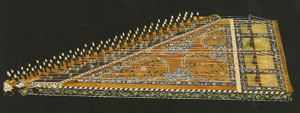Home page
» MUSIC APPLIANCES
» String instruments
» Canon
Canon It belongs to the family of yatıq saz, and is from stringed musical instrument. It was widespread historically in the territory of Near and Middle East, as well as Azerbaijan. The canon was also reflected in the works of miniature art. The instrument passing through a long historical development from time to time got formed and reached our time. U. Hajibeyov noted that canon is the improved instrument in the past. Sides of canon are of different angled wooden box. Bottom and side parts are made of maple, walnut and other solid wood materials. The ¾ of upper part of the instrument is covered with 4 mm thick pine wood, and the rest is covered with fish skin. In the wood covered part there are 3 resonator holes. In leather-covered part of the instrument along the entire width the wooden stretcher is placed. Strings are fixed on the special hollows in the body and passing over this stretcher it is connected to tuning peg. In the part of tuning peg the iron bars are located under the strings. While strings are lifted and lowered tune and semi-tunes are obtained. Tripled 24 (Total 72) raw of string are linked to canon. Strings made of gut or silk thread at early periods on special way. At present, kapron threads are used. The canon put on knee is sounded with ebonite mizrab located between iron thimbles placed on fourth finger. By means of four cornered iron key the instrument is tuned. The total length of canon is 800-900 mm, width is 380-400 mm, and thickness is of 40-50 mm. Its diapason is from big octave’s sol” to the second octaves’ si bemol sound, three and half octave. It has diatonic sound structure. Canon is used in orchestra of folk instruments and ensembles as accompanying and solo instrument.
|
